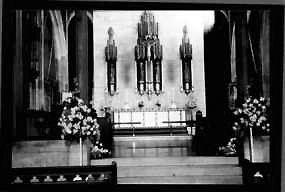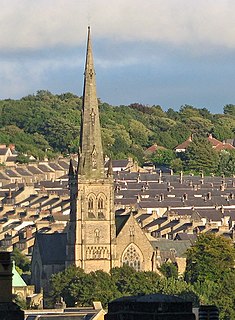
Lancaster Cathedral, also known as The Cathedral Church of St Peter and Saint Peter's Cathedral, is in St Peter's Road, Lancaster, Lancashire, England. It was a Roman Catholic parish church until 1924, when it was elevated to the status of a cathedral. It started as a mission church in 1798, and the present church was built on a different site in 1857–59. It was designed by E. G. Paley in the Gothic Revival style. In 1901 a baptistry was added by Austin and Paley, and the east end was reordered in 1995 by Francis Roberts. The cathedral is in active use, arranging services, concerts and other events, and is open to visitors. The building is recorded in the National Heritage List for England as a designated Grade II* listed building.

The Church of St Agnes and St Pancras is in Ullet Road, Toxteth Park, Liverpool, England. It is recorded in the National Heritage List for England as a designated Grade I listed building, and is an active Anglican church in the diocese of Liverpool, the archdeaconry of Liverpool and the deanery of Toxteth and Wavertree. Pevsner described it as "by far the most beautiful Victorian church of Liverpool...an epitome of Late Victorian nobility in church design".

The Church of St Clare is on the corner of Arundel Avenue and York Avenue in the Sefton Park area of Liverpool, Merseyside, England. It is recorded in the National Heritage List for England as a designated Grade I listed building, and is an active Roman Catholic parish church in the Archdiocese of Liverpool and the Pastoral Area of Liverpool South. It is the only Grade I listed Roman Catholic church in the Archdiocese of Liverpool. Sharples and Pollard consider it to be "one of the most imaginative churches of its date in the country".

The Church of St. Margaret of Antioch is in Prince's Road, Toxteth, Liverpool, England. It is an active Anglican parish church in the diocese of Liverpool, the archdeaconry of Liverpool, and the deanery of Toxteth and Wavertree. The church is recorded in the National Heritage List for England as a designated Grade II* listed building.

St Bartholomew's Church, dedicated to the apostle Bartholomew, is an Anglican church in Brighton, England. The neo-gothic building is located on Ann Street, on a sloping site between Brighton railway station and the A23 London Road, adjacent to the New England Quarter development. It is notable for its height – dominating the streets around it and being visible from many parts of the city – and its distinctive red-brick construction.

St Martin's Church is an Anglican church in Brighton, England, dating from the mid-Victorian era. It is located on the Lewes Road in the Round Hill area of the city, northeast of the city centre and approximately 1.1 miles (1.8 km) north of the seafront. It is the largest church in Brighton by capacity and is noted for its ornate interior.

St. Michael's Church is an Anglican church in Brighton, England, dating from the mid-Victorian era. Located on Victoria Road in the Montpelier area, to the east of Montpelier Road, it is one of the largest churches in the city of Brighton and Hove. The church is a Grade I listed building.

St Oswald's Church is north of the village of Brereton Green, adjacent to Brereton Hall, in the civil parish of Brereton, Cheshire, England, on the banks of the River Croco. It is recorded in the National Heritage List for England as a designated Grade II* listed building, and is described as "an unusually complete late Perpendicular church". It is an active Anglican parish church in the diocese of Chester, the archdeaconry of Macclesfield and the deanery of Congleton. Its benefice is combined with those of Christ Church, Eaton, and St Michael, Hulme Walfield.

St Helen's Church is in the village of Tarporley, Cheshire, England. It is an active Anglican parish church in the diocese of Chester, the archdeaconry of Chester and the deanery of Malpas. Its benefice is united with those of St John and Holy Cross, Cotebrook, St Thomas, Eaton, and St Paul, Utkinton. The church is recorded in the National Heritage List for England as a designated Grade II* listed building.

All Saints Hove is an Anglican church in Hove, part of the English city of Brighton and Hove. It has served as the parish church for the whole of Hove since 1892, and stands in a prominent location at a major crossroads in central Hove.
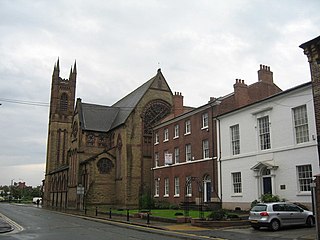
St Mary's Church, or St Mary's Priory, is in the town centre of Warrington, Cheshire, England. It is recorded in the National Heritage List for England as a designated Grade II listed building, and is an active Catholic church. The parish was established and served by Benedictine monks from Ampleforth Abbey, but following the withdrawal of Ampleforth Abbey from the parish in 2012, it was served by the priest from St Benedict's Church, Warrington. From November 2015, the church has been owned and served by priests from the Priestly Fraternity of Saint Peter (FSSP) as a shrine church dedicated to the celebration of the sacraments of the pre-Vatican II form of the Roman Rite. It is well known for the beauty and reverence of its liturgy and the ambition and excellence of the church choir and music.
Stephen Ernest Dykes Bower was a British church architect and Gothic Revival designer best known for his work at Westminster Abbey, Bury St Edmunds Cathedral and the Chapel at Lancing College. As an architect he was a devoted and determined champion of the Gothic Revival style through its most unpopular years. He rejected modernism and continued traditions from the late Victorian period, emphasising fine detail, craftsmanship and bright colour.

St Paul's Church is in Crown Hill, Grange-over-Sands, Cumbria, England. It is an active Anglican parish church in the deanery of Windermere, the archdeaconry of Westmorland and Furness, and the diocese of Carlisle. Its benefice is united with those of St Mary, Allithwiate, St Mary and St Michael, Cartmel, St Peter, Field Broughton, St John the Baptist, Flookburgh, Grange Fell Church, Grange-Over-Sands, and St Paul, Lindale, to form the benefice of Cartmel Peninsula. The church is recorded in the National Heritage List for England as a designated Grade II listed building.

St Peter's Church is in the village of Field Broughton, Cumbria, England. It is an active Anglican parish church in the deanery of Windermere, the archdeaconry of Westmorland and Furness, and the diocese of Carlisle. Its benefice is united with those of St Mary, Allithwiate, St Mary and St Michael, Cartmel, St John the Baptist, Flookburgh, St Paul, Grange-over-Sands, Grange Fell Church, Grange-Over-Sands, and St Paul, Lindale, to form the benefice of Cartmel Peninsula. The church is recorded in the National Heritage List for England as a designated Grade II* listed building.

St Mary's Church is in St Mary's Street, Crewe, Cheshire, England. It is an active Roman Catholic parish church in the diocese of Shrewsbury. The church is recorded in the National Heritage List for England as a designated Grade II listed building.

The Church of St Vincent de Paul is a Roman Catholic parish church in St James Street, Liverpool, England. It is an active parish church in the Archdiocese of Liverpool and the Pastoral Area of Liverpool South. The church is recorded in the National Heritage List for England as a designated Grade II* listed building.

The Church of Holy Trinity and St George is in New Road, Kendal, Cumbria, England. It is an active Roman Catholic parish church in the diocese of Lancaster. It is recorded in the National Heritage List for England as a designated Grade II* listed building. The church was founded by the parish priest, Thomas Wilkinson, and designed by local architect George Webster. Architectural historians regard the church as the best of the three designed by Webster in the town.
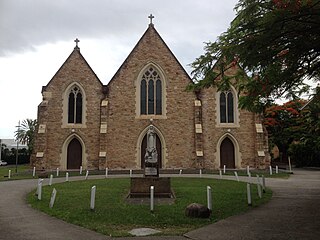
St Patricks Church is a heritage-listed Roman Catholic church at 58 Morgan Street, Fortitude Valley, City of Brisbane, Queensland, Australia. It was designed by Andrea Giovanni Stombuco and built from 1880 to 1882 by John Arthur Manis O'Keefe. It was added to the Queensland Heritage Register on 21 October 1992.

St Paul and St Stephen's Church is a Church of England church located in Stroud Road, Gloucester, Gloucestershire. St Paul's church was built between 1882 and 1883. St Stephen's church was built between 1898 and 1900. St Stephen's church was closed in 2010 and the church was merged with St Paul's which became St Paul and St Stephen's church. Closely associated with the church is St Paul's Church of England Primary school located in New Street, Gloucester which opened in 1870.
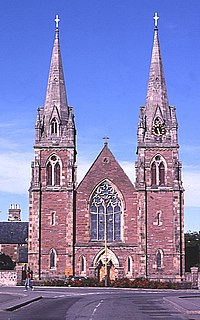
St Peter's Roman Catholic Church is a large mid-nineteenth century church in Buckie, Moray, Scotland. Known locally as the Buckie Cathedral, it was built between 1851 and 1857, soon after the emancipation of Catholics in Scotland, to provide a place of worship for the local Catholic congregation. It was designed by James Kyle, Catholic bishop of Aberdeen, and built on land donated to the diocese by Sir William Gordon, Baronet of Letterfourie. It was extended and redecorated in the early twentieth century by Charles Ménart, and was designated a Category A listed building in 1972. It remains an active place of worship, under the governance of the Roman Catholic Diocese of Aberdeen.


